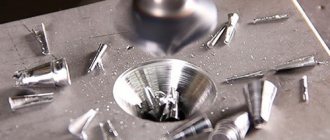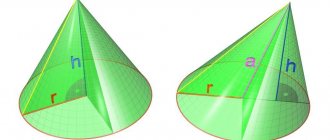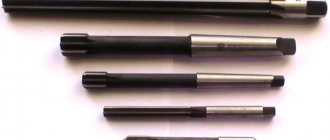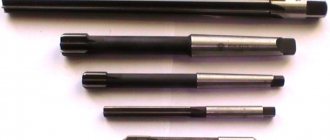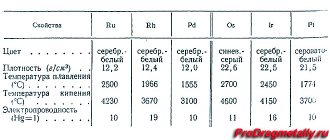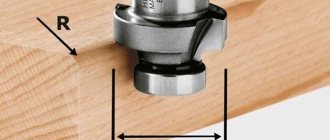A cutting type tool is designed for finishing cleaning of holes obtained by drilling, boring and countersinking. Reaming, thanks to a large number of edges, from 4 to 14, allows you to achieve accuracy of up to 9 quality. The tool rotates while simultaneously making translational movements along the axis. To achieve maximum accuracy, it is recommended to use lubricating coolants.
Types of scans
— Machine type , equipped with a shank in the form of a Morse cone or cylinder, necessary to obtain a smooth surface after drilling and adjusting the hole to the exact dimensions. They are distinguished between solid and mounted according to the method of fastening;
— Manual reamers , made in the shape of a cylinder, have sharp edges (helical and straight) along the entire length. For a comfortable grip, it is used simultaneously with the crank;
— Adjustable , allow you to set different diameters in the range from 1 to 3 mm;
— Expanding or sliding , inside of which there is a ball and a screw at the bottom. By driving the screw, the ball moves forward, thereby moving the edges apart and increasing the diameter of the tool;
— Conical , cone-shaped, used in industry.
Possible applications
Depending on the design, adjustable reamers are divided into expanding and sliding. The principle of operation of the tool is the same - when the cutting plates are shifted up or down, the diameter increases or decreases, respectively. The difference is in the tightening method and the range of adjustable diameter. In expanding ones there are two nuts for this (upper and lower) and the maximum increase in size is from 0.25 to 3 mm. depending on diameter. The size of the sliding adjustable reamers is changed by tightening the screw, which ensures the movement of the ball inside the housing that opens the knives. Sliding reamers are more accurate, the maximum increase in diameter is 0.15 - 0.5 mm.
Otherwise, the design of the reamers is similar and consists of a body made of inexpensive structural steel and insert knives. The latter are made of thin plates of more expensive tool steel and can be removed, sharpened, or replaced with new ones when worn.
Unlike solid ones, adjustable reamers allow you to change the diameter by tenths and even hundredths of a millimeter; they are more cost-effective due to the ability to replace knives. Depending on the method of application, they can be manual or machine, have a cylindrical or square shank for a quick-release chuck.
Sweep operating principle
The operating principle of the tool lies in its edges - teeth. There can be from 4 to 14. Thanks to the edges, the allowance is removed during the processing of the hole. Not only does the rotation of the tool help the drilling process, the feed, which is performed in the direction towards the axis of the calibrated armhole, is also important. Due to the principle of operation, it is possible to remove the thinnest layer of metal from the product without damaging either the surface or the tool. A metal-cutting product, mechanical or manual, can make an ultra-precise hole with minimal roughness.
Reamer design
The reamer consists of a cutting surface, a calibrating part, teeth, grooves, clamps, back and front cutting angles. The cone angle varies in the cutting part. For hand tools it is 1-2 degrees, and for machine equipment it reaches 15 degrees. The calibration part consists of a conical and cylindrical section.
The cylindrical base grades the hole in the metal product, and the purpose of the reverse taper is to reduce friction during the calibration process. The rigidity and accuracy of the tool depends on the number of teeth. The more teeth there are, the more accurate and cleaner the hole is. The grooves in the reamer are responsible for control and smooth processing of products. For example, when working with uneven surfaces, a tool with a screw tooth is used - there the grooves are hollowed out in the direction opposite to the rotation - this is necessary so that the reamer does not jam during the drilling process. The rear cutting angle of the product is responsible for the durability of the equipment; it is usually made at an angle of 5-8 degrees. And the rake angle is zero.
Types
Reamer chuck
Duplex Straight Shank High Speed Steel Clamping Reamer [1]
Chuck reamers or machine reamers are the most common type of reamer used in lathes, drilling machines and screw machines that provide a smooth finish to the hole. They come in a variety of grooves and serrations (e.g. right-hand cut, left-hand helix, straight groove) as well as different types of shanks. Chuck reamers can be manufactured with a straight shank or a Morse taper shank. [2]
Adjustable manual sweep
Adjustable manual reamer
The adjustable manual reamer can cover a small range of sizes. They are usually designated by a letter that corresponds to a size range. Disposable blades slide along a conical groove. Tightening and loosening the limit nuts on each end changes the size that can be cut. The lack of helix in the grooves limits their ease of use (minimal material removal per adjustment) as they tend to chatter. They can also only be used in unbroken holes. If the hole has an axial cut along it, such as with a split sleeve or clamping hole, each straight tooth will drop
into the gap, causing the other teeth to be pulled out of the cutting position.
This also creates chatter marks and prevents the reamer from being used to size
the hole.
Forward scan
Straight reamer is used to slightly enlarge the hole. The input end of the reamer will have a small cone, the length of which will depend on its type. This causes a self-centering action when entering an untreated hole. Most of the length will have a constant diameter.
Reamed holes are used to create holes of precise roundness and size, such as -0/+0.02 mm (0.0008 in) tolerances. This will allow force installation of locating pins that otherwise do not need to be held in the housing holder. The other holes, widened a little more in other parts, fit these pins exactly, but not so tightly as to make disassembly difficult. This type of alignment is common when connecting crankcase halves to the connectors that are used in motorcycle engines and boxer type engines. Once the halves are joined, the assembled housing can be bored (using a large-diameter reamer) and then disassembled to install bearings and other parts. The use of pre-drilled dowel holes is typical of any machine design where any two fixing parts must be positioned and mate precisely with each other - usually, as stated above, to within 0.02 mm or less than 0.001 inch.
Another use for reamed holes is to install a special non-threaded shoulder bolt, also called a shoulder bolt. This type of bolt is commonly used to replace hot-formed rivets during seismic retrofitting of structures.
Manual sweep
Manual reamer has a longer taper or lead into
in front than the machine scan. This is done to compensate for the difficulty of starting the hole with one hand. This also allows the reamer to be deployed straight and reduces the risk of breakage. The grooves can be straight or spiral.
Machine scan
Machine reamer with spiral grooves
The machine reamer has a very small inward approach. Since the reamer and workpiece are pre-aligned by the machine, there is no risk of off-course. In addition, the constant cutting force that the machine can apply ensures that cutting starts immediately. The advantage of spiral flutes is that they remove chips automatically, but are also available with straight flutes since the amount of chips generated during the reaming operation must be very small.
Rose scan
The rosette reamer has no relief on the periphery and is offset by the front cone to prevent jamming. Secondarily, they are used as softening expanders.
Shell expander
Shell reamers are designed for reaming bearings and other similar products. They are grooved almost the entire length.
Conical reamer
Four Small Taper Pin Reamers
A precision taper reamer is used to create a tapered hole into which the taper pin will later be inserted. The conical pin is a self-tightening device due to the small angle of the cone. They can be driven into a conical hole in such a way that removal can only be accomplished with a hammer and punch. They have size
in numerical order (for example, a No. 4 reamer would use No. 4 tapered pins). Such precision joints are used in aircraft assembly and are often used to join two or more wing sections used in an airframe. They can be re-deployed one or more times during the life of the aircraft, with an appropriately sized pin replacing the previous pin.
Morse Taper Reamer
Reamer with Morse taper no 3
Reamer with Morse taper is used for processing sleeves with Morse taper manually. These bushings are a tool used to hold cutting tools or holders in the spindles of machines such as a drill or router. The reamer shown is a finishing reamer. The roughing reamer should have teeth along the grooves to break up the thicker chips produced by heavier cutting action.
Combined scan
This combination reamer was designed for long-term use of electronic parts with tight tolerances.
A combined reamer has two or more cutting surfaces. Combined reaming is precision grinding in a pattern resembling several internal diameters of a part. The advantage of using a combination reamer is that it reduces the number of turret operations while maintaining depth, ID and alignment more accurately. Combination reamers are primarily used in screw machines or second operation lathes rather than computer numerically controlled (NC) machines because G-code can be easily created for ID profiling.
Combination reamers can be made from cobalt, carbide, or high-speed steel tools. When using combination reamers to ream a large internal diameter from a material with a smaller surface area per minute, carbide tips can be brazed onto a configured drill blank to assemble the reamer. Carbide requires special care because it is very brittle and will crack if vibration occurs. Typically a drill or combination drill is used to remove the bulk of the material to reduce wear or the risk of the part slipping out of the combination reamer.
Conical reamer (inaccurate)
Cone Reamer
A cone reamer can be used to remove burrs from a drilled hole or to enlarge a hole. The body of the instrument tapers towards the end. This type of reamer consists of a body, which is usually up to 1/2 inch in diameter, with a rod crossbar at the large end to form the handle. This is especially useful for machining softer metals such as aluminum, copper and mild steel. Another name for this is "maintenance reamer", referring to its use in various deburring and enlargement tasks often found in maintenance work. A similar tool can be seen when selecting Swiss Army Knives, such as the Electrician's model, for use on conduit.
Hole Reaming Process
Reaming the holes is necessary to create an armhole with a precise shape in a metal product with an acceptable roughness of 0.16 to 1.125 micromillimeters. The unwrapping process is performed using unwrapping. The size of the tool is selected in accordance with the diameter of the hole. First, a rough hole is drilled in the workpiece. Then this workpiece is secured so that the equipment can freely pass through the product with the hole. For rough reaming, mineral oils are sometimes used to lubricate the surfaces of the tool and workpiece. After rough reaming, a finishing tool is inserted into the hole, and the operation is repeated again until the desired quality is achieved.
Reaming or drilling to required size
The geometry of the hole drilled into metal by a twist drill may not be precise enough (close enough to a true cylinder of a certain exact diameter) and may not have the required smoothness and surface finish for certain engineering applications. Although modern twist drills can perform excellently in many applications—usually producing fairly accurate holes for most applications—sometimes the strict requirements of hole geometry and finish require two operations: drilling to a small diameter and then reaming with a reamer. The planned difference between the drill diameter and the reamer diameter is called resolution
. (This allows a small amount of material to be removed.) The allowance should be boring [especially single point boring] and internal cylindrical grinding.)
Sharpening reamers
Sharpening of metal cutting tools should only be carried out by an experienced and highly qualified craftsman. Since a reamer is considered a finishing tool, the quality of its sharpening must be ideal. This is a complex operation that is performed on a special sharpening machine. The tool teeth are processed according to a roughness classification of at least 8th or 9th class. For accuracy of repair, the development angles are checked with a protractor or using a special microscope for instruments. After grinding, the reamer is further processed by finishing on a professional finishing mechanism.
What holes are machined with reamers?
The master can process cylindrical or conical holes with a cutting tool. Cylindrical armholes are created by reamers with the main part in the shape of a cylinder. Use hand or machine tools.
Conical holes are made with conical-shaped reamers, but not immediately. Typically, the process is divided into three stages: roughing, intermediate and finishing. The finished conical hole is checked using a cutting product with a conical gauge.
Recommendations
- "Clamp Reamers | Gammons Hoglund." gammons.com
. Retrieved 2020-07-22. - "Clamp Reamers | Gammons Hoglund." gammons.com
. Retrieved 2020-07-15. - "A Study of Reamers". calvalves.com. Retrieved 2013-11-17.
- "Engine Valve Guide Reaming." calvalves.com. Retrieved 2013-11-17.
- ^ a b c d e
Todd, Allen and Elting, 1994, pp. 109–115 - “Adjustable Cold Air Gun and Adjustable Hot Air Gun using Vortex Tube and Compressed Air by ITW Vortec, Vortex Tubes, Vortex Tubes, Compressed Air Cooling.” Newmantools.com. Retrieved 2013-11-17.
- https://www.asme.org/products/codes-standards/b942-1995-reamers
Bibliography
- Todd, Robert H.; Allen, Dell K.; Alting, Leo (1994), Manufacturing Processes Reference Guide
, Industrial Press Inc., ISBN 0-8311-3049-0.
How to care for a reamer
Restoring this instrument can cost a lot of money. To avoid unexpected expenses, you should carefully monitor the condition of the reamers: protect them from moisture, buy a storage unit, and clean them after each use.
Contents: Hide Open
A reamer is a precision cutting tool used for finishing various shapes of holes, giving them the required accuracy and roughness. The main purpose of the reamer is to fine-tune holes after drilling, boring or countersinking; it allows you to achieve grade 6-9 accuracy and roughness up to Ra = 0.32...1.25 microns.
Classification of scans
In metalworking, various types of reamers are used, divided according to the following characteristics:
Hole shape:
- Cylindrical reamers.
- Conical reamers for various types of cones.
- Step developments.
Hole Reaming Accuracy:
- Quality number for cylindrical tools.
- Hole processing level (roughing, intermediate, finishing) – for conical ones.
- Adjustable reamers – sliding, pivot or expanding.
Clamping method:
- Hand-held with square shank.
- Cylindrical shank (machine reamers).
- Conical machine.
- Machine mounted.
Reamers are also divided according to the number of cutting edges, material and shape of the grooves for chip removal (spiral or straight).
Mode of application
A machine reamer can be installed in a drilling or lathe; a manual reamer requires a crank. To set the expansion reamer size, you will need two keys. Having unscrewed the upper nut, you need to tighten the lower one until the required size is obtained. To adjust the sliding reamer, you will need a screwdriver, which must be used to tighten the screw located at the end until the required size is obtained. When installing a reamer, you will definitely need a caliper or, if you need to obtain a particularly accurate size, a micrometer.
News
Delivery - as usual
Targeted delivery to the transport company
Reamer design
High quality processing is ensured by the design of the reamer - a large number of cutting edges providing a small allowance when removing metal. The cutting process is carried out during rotation and simultaneous translational movement of the tool along the axis of the hole being machined.
Above are pictures of four types of scans:
- a) Manual with a cylindrical shank.
- b) Machine made with a tapered shank, solid.
- c) Machine one-piece
- d) Machine assembly with replaceable cutting elements.
The tool has from 6 to 16 teeth (usually) unevenly distributed around the circumference to improve the quality of processing. Let's look at the design using the example of a manual solid reamer with a cylindrical shank. The tool consists of three main parts - the working part, the neck and the shank. In turn, the working part of the reamer consists of a guide, cutting and calibrating parts, as well as a reverse cone. The main part of the process is performed by the cutting part, which is much longer for a hand tool than for a machine tool.
Basic techniques for working with sweeps
The drill for preparing the hole is selected to match the diameters of the metal reamers. There must be a small allowance - the drill should be 0.2 - 0.3 mm smaller for rough reaming, and no more than 0.05 - 0.1 mm for finishing. Allowance values greater than those specified can cause rapid wear of the intake part of the reamer, deteriorating the accuracy of the result and the quality of the surface.
For manual sweep:
- The reamer is attached to the collar and lubricated.
- The intake part must fit in such a way that the axes of the reamer and the hole completely coincide.
- To check the position of the reamer, you can use a square in two planes located perpendicular to each other.
- Start rotating to the right with slight pressure from above.
- Rotate smoothly, at low speed, without jerking. Do not speed up the rotation even at a light speed.
- Reverse rotation is unacceptable, as it may cause breakage of the cutting edges and burrs on the surface of the hole. Reaming is carried out in one pass on one side.
Tips for machine scanning:
- The reamer is attached in the same way as a drill. The process itself is similar to drilling and it is advisable to perform it without changing the installation of the part, immediately after preparing the hole.
- Often the reamer is mounted in oscillating holders, which allows the tool to self-center along the axis of the hole.
- It is advisable to use automatic feed; the cutting speed should be 2-3 times lower than when drilling.
- A significant amount of lubricant must be used.
- The lower the number of revolutions and feed speed, the higher the quality of the hole and tool life.
Current GOSTs
Defines scanning parameters according to GOST 29240-91. Tolerances are regulated by GOST 11173-76. Also, each type of reamer has its own current standard that determines its design and dimensions. For manual cylindrical ones - GOST 7722-77, for machine solid ones - GOST 1672-80, etc. for all types of tools.
Reamers for metal allow you to obtain holes of accuracy classes 2 and 3, and cleanliness classes 7 and 8.
There are 2 main types of sweeps:
Manual reamer sizes:
Cylindrical development:
— nominal diameter: from 3 (mm) to 50 (mm); — total length: from 80 (mm) to 360 (mm); — length of the cutting part: from 40 (mm) to 190 (mm); — length of the cutting part: from 4 to 10 d; - reverse taper value: 0.01 - 0.05 (mm) per 100 (mm); - rake angle: 5 - 10 °; — back angle: 5 — 12 °.
Conical reamer:
— diameter of the middle part of the cone: from 7.067 (mm) to 44.399 (mm); — minimum cone diameter: from 6.39 (mm) to 40.978 (mm); — maximum cone diameter: from 7.64 (mm) to 45.715 (mm); — total length: from 55 (mm) to 170 (mm); — length of the cutting part: from 24 (mm) to 90 (mm); — documentation: GOST 11181-71.
Machine reamer sizes:
Machine-mounted reamer with plates:
— nominal outer diameter: from 34 (mm) to 50 (mm); — internal diameter: from 13 (mm) to 22 (mm); — total length: from 40 (mm) to 55 (mm); — number of teeth: from 6 (mm) to 10 (mm).
Content
- 1 Construction
- 2 Reaming or drilling to required size
- 3 Types 3.1 Reamer chuck
- 3.2 Adjustable manual sweep
- 3.3 Direct sweep 3.3.1 Manual sweep
- 3.3.2 Machine scanning
- 3.6.1 Morse taper scan
- 4.1 Size - accuracy and repeatability
- 7.1 Bibliography
